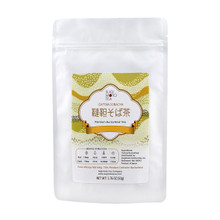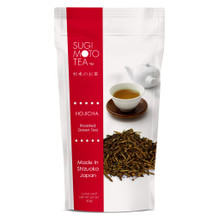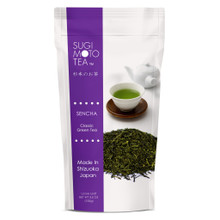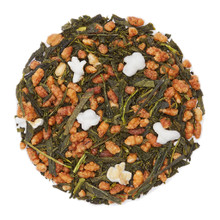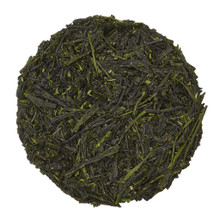From Leaf to Cup: How Matcha is Made
Matcha, a powdered green tea primarily produced in Japan, is made from shade-grown tea leaves. Traditionally, it is used in the Japanese tea ceremony where it's mixed with water to create a smooth froth using a chasen, a special whisk. However, due to its flavor and health benefits, matcha has gained worldwide popularity in the past few decades. It's now used in a variety of ways, from supplements to dessert ingredients.
While matcha by itself is widely recognized, the specifics of its production aren't as commonly known. In this blog, we'll explore the history of matcha, its production process, and the different grades available. We'll also highlight tencha, the shade-grown tea leaves ground to make matcha. Not only do these leaves play a crucial role in matcha production, but they can also be enjoyed as a flavorful tea in their own right.
The Tea Plant (Camellia sinensis)
The production of tencha, and subsequently matcha, begins with the cultivation of the Camellia sinensis, the plant responsible for producing all true teas. An evergreen plant from subtropical regions, Camellia sinensis originates from China and is believed to have arrived in Japan in 805 via the Buddhist monk Saicho. However, it wasn't until the 12th century that tea cultivation became more widespread in Japan. Today, only about 4% of the native varieties of Camellia sinensis remain, with Japan-born cultivars accounting for 96% of all plants used for tea production. More information about cultivars and their significance in matcha and green tea production can be found in our previous blog post, Navigating the World of Green Tea Cultivars.
Shading, a vital step in tencha cultivation, involves covering tea plants to reduce sunlight exposure during the final weeks before harvest. This process restricts the plant's photosynthesis capability, enhancing chlorophyll production, which results in a vibrant green color. Additionally, shaded plants yield more amino acids like L-Theanine, which contributes to matcha's umami taste. Traditionally, shading was accomplished by covering tea plants with criss-crossed layers of natural materials like straw and bamboo. Nowadays, direct shading with a large black tarp over the tea plants is the most common method.
The shaded leaves are then harvested and steamed in a process known as "kill-green," crucial for green tea production. After cooling, the leaves are dried and the stems are separated as they are not used in matcha production. Following a final drying, tencha is produced. To transform tencha into matcha, it is milled into a fine powder.
Grades of Matcha
When shopping for matcha, you'll often see it labeled as either ceremonial or culinary grade. These represent two general grades, each serving different purposes and preferences. Ceremonial matcha is higher quality, as it's the grade traditionally used in Japanese tea ceremonies. Conversely, culinary matcha is intended for cooking or blended drinks, as its name suggests.
One key distinction between these grades is the harvest season. Ceremonial matcha comes from the spring harvest. During the dormant winter period, tea plants produce and store nutrients, which are then sent to the leaves and buds at the start of spring. Hence, spring-harvested teas have the highest nutrient concentrations.
Another notable difference is the shading duration. Shading increases chlorophyll production, leading to a vibrant green color and higher amino acid content. Ceremonial matcha is shaded for up to 20 days, while culinary matcha is typically shaded for about a week or possibly not at all. Organic matcha is an exception, as it's often shaded for a shorter period due to nutrient management restrictions compared to conventional farming. As shading prevents photosynthesis, the plant's food production, organic matcha's shading duration may be reduced to balance the plant's needs while maintaining the product's organic integrity.
Apart from harvest season and shading degree, ceremonial matcha may be hand-harvested or stone-milled, like our Sugimoto Reserve Mizuki Matcha. However, with technological advancements and labor costs, this is becoming less common. A stone mill can only grind about 40g of matcha per hour, whereas an industrial matcha grinding machine can produce 20-25kg of matcha per hour. This significant difference highlights the evolution and modernization of matcha production techniques.
So, how does this affect the taste and appearance of ceremonial and culinary matcha? Due to the earlier harvest and longer shading, ceremonial matcha is nutritionally richer, has a more vibrant color, and a sweeter, more delicate flavor. Culinary matcha, although still nutrient-rich, is lower in caffeine and theanine, has a slightly duller color, and has a stronger, often more bitter taste. This stronger flavor makes culinary matcha suitable for baking or blending, hence its categorization as "culinary". It's excellent for baking cakes or blending into smoothies. The more delicate flavor of ceremonial matcha would be lost in recipes and is best savored on its own.
Brewing and Enjoying Tencha
Our Organic Tencha is a masterful blend of the cultivars Sae Midori, Asanoka, and Oku Midori. It offers a sweet, malty aroma with artichoke notes. Hints of dried raspberry can be picked up from the dry leaf. The flavor is rich in umami, light in bitterness, and devoid of astringency. It has a slight nuttiness, similar to almond, with notes of broccoli stem and sweet pea. While this tea is typically grown and milled for matcha production, it can also be savored as a loose-leaf tea. We also recommend those with their own stone mills, countertop matcha machines, or mortar and pestles to grind our tencha and create freshly-milled matcha at home.
In conclusion, the production of matcha is an artful journey that begins with the Camellia sinensis plant and culminates in the vibrant green powder cherished globally. The unique shading process, meticulous steaming, and careful grinding of tencha leaves are steps that embody centuries of tradition and expertise. Whether it's the delicate, nutrient-rich ceremonial matcha or the robust culinary grade used in innovative recipes, each sip of matcha is a testament to the harmony of nature and skilled craftsmanship. As we enjoy this storied tea, let's savor not just its flavor, but the rich history and artistry it represents.















